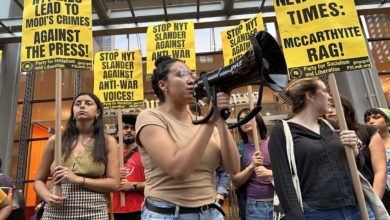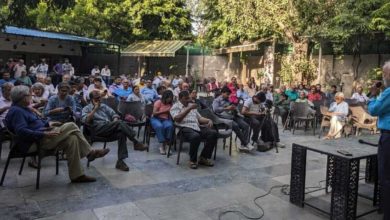On Aug. 14, Indian government forces killed two
people in the Indian-controlled Kashmir region. The killings were the latest in
a cycle of large, and at times violent, protests met by state forces using
firearms. Each police shooting has led to subsequent demonstrations of up to
tens of thousands, and then more killings by the police.
|
|
India’s Prime
Minister Manmohan Singh has stated his willingness to grant autonomy to the
people of Kashmir. Singh has called for calm and declared his readiness to
negotiate with any force in Kashmir, so long as it is within the context of the
region remaining under Indian control. At the same time, Singh has deployed
thousands of additional troops, and regional authorities have re-imposed a
strict curfew in Srinagar and most major towns of the area. The key demand of
the demonstrators is an end to Indian control over Kashmir, either to form an
independent state or to become part of Pakistan.
Over the decades, the human toll of the conflict
has been huge. Since the beginning of the recent round of protests in June, at
least 57 people have been killed. Going back to the late 1980s, over 68,000
people, mostly civilians, have been killed by Indian police and military.
India is a country with a large diversity of
nationalities and religions, as well as remnants of the caste system. Hindus
constitute the majority of the population, with Muslims and Sikhs being
sizeable minorities, alongside Buddhists, Christians and others. There are approximately 138 million
Muslims in India, constituting over 13 percent of the population. The entire
Kashmir region, some of which is Pakistani-controlled, has a total population
of over 13 million, about 8
million in the Indian-controlled state of Kashmir and Jammu. In Kashmir and Jammu, Muslims constitute 74
percent of the total population, Hindus 24 percent and Buddhists less than 2
percent. In Kashmir Valley, Muslims constitute over 95 percent of the population,
and Hindus only 3 percent.
Religious conflicts class-based
Religious conflicts are class-based. In modern history,
religious conflicts can be traced to the colonizers’ efforts to consolidate
their rule and prevent the colonized people from uniting against their real
enemies—the colonizers. Even today, when the formerly colonized countries have
gained nominal independence, imperialist countries continue to promote ethnic
and religious conflicts to maintain their neocolonial control.
The conflict of Kashmir, in the context of India’s colonized
past, is a direct result of forces set in motion by the British Empire. Britain
colonized India for over 200 years, plundering its resources and pushing
millions of people into abject poverty. Britain was able to turn the Indian
subcontinent into the jewel in the crown of its empire due to its military
superiority, made possible by its more advanced industry. But Britain, a small
country, needed more than just military might to subjugate the people of a huge
country with several times the size and population of its own. So the British
Empire mastered a divide-and-conquer strategy early in its bloody colonial
history.
Britain consciously promoted conflicts
between Hindus and Muslims. It divided India into small, easily manageable
chunks. Some regions were given the status of “princely states,” where the
British installed maharajas (princes). In exchange for safeguarding colonial
rule, the maharaja would earn the right to exploit the peasants and toiling
masses and enjoy the protection of the colonizers.
A
common tactic of the British
A common tactic implemented by the
British in the administration of these “princely states” was installing Hindu
rulers in majority Muslim areas and Muslim rulers in majority Hindu areas. This
tactic had two concrete benefits for the British. First, it would create a
false enemy for the populations—the people of the other religion. Additionally,
it guaranteed the loyalty of the local ruler. Being hated and despised by the
majority of the population made it impossible for the local ruler to double-cross
the British and go independent. His survival depended on outside support.
This power configuration was not unlike
what exists today with relation to the modern state of Israel. U.S. imperialism
can rely on Israel more than any of its other allies/clients in the Middle East,
because, amid a sea of oppressed Palestinians and Arabs, the very survival of
this colonial settler state is entirely dependent on imperialist sponsorship.
In 1846, through the Treaty
of Amritsar, the British sold part of the state of Lahore, which they had
invaded, to a Hindu maharajah by the name of Gulab Singh. Thus, the state of
Kashmir was formed. Having been ruled by a Muslim empire for centuries, a
strong majority of the population of the territory was Muslim. Maharajah Gulab
Singh purchased the newly created “princely state” by paying the British 7.5
million rupees. Predictably, conflict between Muslims and Hindus ensued,
resulting in periodic clashes.
In
1906, Mohammed Ali Jinnah founded the Muslim League, a Muslim nationalist party
that was to develop close ties with the British. At the height of India’s
anti-colonial struggle, when tens of thousands of Congress Party members were
in prison, under the leadership of Mahatma Gandhi, the Congress Party refused
to fight on the side of their colonizers in World War II. But Jinnah’s Muslim
League joined the British.
Following
World War II, decades of Indian anti-colonial struggle made it impossible for
the declining British Empire to hold on to their colony. Breaking up India was
the next best thing for them, especially since a part of it could be ruled by
Jinnah, someone they controlled.
On July 18, 1947, the British
Parliament passed the Indian Independence Act, relinquishing Britain’s hold
over India, but also partitioning India along religious lines. India’s majority Muslim provinces were to become part of
Pakistan; majority Hindu provinces part of India.
The Islamic Republic of Pakistan
was formed under Jinnah’s rule. The partition, of course, was not motivated by
Britain’s concern for the rights of India’s Muslim minority. It was a means of
weakening what was to become the independent state of India. The partition
caused the largest migration in human history, with 17 million people fleeing
across the newly formed borders in both directions to escape the accompanying
ethnic violence.
Under the terms the British
set for the partition, the rulers of the 550 “princely states” would each get
to choose which state their area would join, India or Pakistan. Of course the
decision was strictly the ruler’s, not that of the population. Kashmir,
situated just between India and Pakistan, was one of the largest “princely
states.” At the time of the partition, the ruler of Kashmir was Maharajah Hari
Singh, a descendent of Gulab Singh, who had “bought” Kashmir from the British.
While Singh was still uncommitted and considering independence for Kashmir, the
first of several wars between India and Pakistan over Kashmir broke out.
Pakistan sent its military
into Kashmir, followed by India’s military deployment by airlifting its forces.
Facing the possibility of complete loss of power if Pakistan were to succeed,
Singh decided to join India on the condition of Kashmir being an autonomous
state. By the end of the war in 1948, India won most of the territory. The
Indian government promised that the fate of Kashmir would ultimately be decided
by a referendum—which has not been held to this day. Over the years, even
the autonomy of Indian-controlled Kashmir has faded away, and this is what the
current prime minister is promising to reinstate.
Following the collapse of the
Soviet Union, India, a country that had been one of the leaders of the
non-aligned movement, shifted to the right. Economic nationalism, championed by
the Congress Party for decades, gave way to the implementation of neoliberal
policies of privatization and cutting government services. The right-wing Hindu
chauvinist Bharatiya Janata Party won the most votes in India’s elections. The
BJP promoted a Hindu nationalist ideology to battle public discontent against
its neoliberal economic policies, thus diverting the anger of Hindus against
Muslims. The BJP is no longer in power today, but anti-Muslim chauvinism has
become a fact of life in Indian politics. Several large-scale massacres, often
aided by the police, have taken place against Muslims.
The crisis of Kashmir is a
living example of the inability of the capitalist class to resolve ethnic
conflicts, even its progressive factions fighting imperialism for independence
in oppressed countries. Gandhi and the other leaders of the Indian independence
movement, while not national chauvinists, failed to implement policies to
create unity between Indians of all nationalities. The fact that Jinnah’s
Muslim League gained popularity and turned toward British imperialism to
improve its position against the mostly Hindu Congress Party was a reflection
of this fact.
Religious and ethnic conflicts not natural and inevitable
Religious and ethnic conflicts are not natural
and inevitable phenomena. When communities are not provoked and set up against
one another, they live in peace and harmony. Only
under capitalism are ethnic conflicts inevitable. Socialist countries have
managed to address the national question successfully, despite having been
invaded, or constantly under the threat of invasion, by imperialist states.
The Soviet Union turned the
vast czarist Russian Empire, the “prison house of nations,” into a country
where people of dozens of different nationalities lived harmoniously. With the
overthrow of the Soviet Union, ethnic massacres promptly resumed. Following
WWII, the Federated Republic of Yugoslavia united Serbs, Croats, Bosnian
Muslims and several other nationalities on the basis of socialist ownership of
the means of production. With the partial return of capitalism to Yugoslavia—the
implementation of the IMF/World Bank austerity measures in the 1980s and 1990s,
Yugoslavia was engulfed in a bloodbath of heart-wrenching ethnic massacres. Of course,
a big part was played by the imperialist funding and promotion of chauvinistic
political forces among each of the nationalities.
Although often shrouded in
religious or nationalistic language, the root cause of religious and ethnic
wars is not strict adherence of different communities to religious dogma or
nationalistic mythologies. Fighting for survival, working people are forced to
engage in a relentless competition for gaining access to resources—land, water,
housing and so on. Bourgeois-national forces, no matter how progressive, are by
nature unable to call off this competition. They do, after all, represent the
interests of a faction of the bourgeoisie, not just against imperialism, but
also against their own country’s working class. And no sector of the capitalist
class can be indifferent to the pursuit of resources and markets.
In contrast, by dispossessing
the capitalist class and through public ownership of the means of production,
socialism lays the material basis for the elimination of national conflicts.
The capitalist class promotes national conflicts to prevent the unity of the
working class and oppressed masses. The socialist state has no interest in
doing that and every reason to promote solidarity among people of different
nationalities. With society’s resources rationally allocated through a planned
economy, the material basis for the competition of different peoples is
removed.
There is a long, hard
struggle ahead, but the working people of India will ultimately win victory,
not by scoring wins against oppressed people of other nationalities and
religions, but by uniting in a struggle against imperialism and their own
capitalist class.







